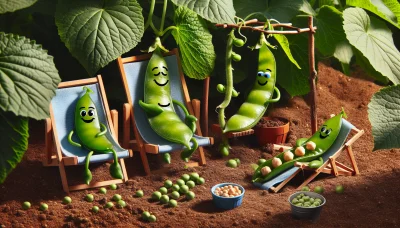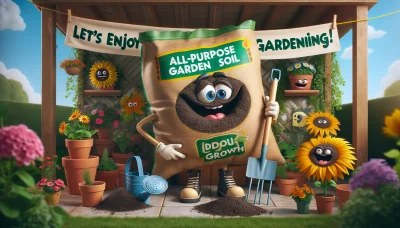How to plant lettuce seeds Quiz
Test Your Knowledge
Question of
How to Plant Lettuce Seeds: A Beginner's Guide
Gardening is not only a rewarding hobby but also a great way to ensure you have fresh, healthy produce right at your doorstep. Among the various vegetables you can grow, lettuce stands out as an excellent choice for beginners. It's easy to plant, grows quickly, and doesn't require much space, making it perfect for small gardens or even containers. Starting your own lettuce garden can introduce you to the joys of gardening and provide you with a steady supply of fresh greens. Let's dive into the simple steps to get your lettuce seeds sprouting in no time.
Choosing the Right Lettuce Seeds
When it comes to gardening, selecting the right lettuce seeds is crucial for a bountiful harvest. There are several varieties of lettuce seeds available, each suited to different climates and seasons. The most common types include Romaine, Butterhead, Iceberg, and Leaf lettuces. Each variety has its unique texture, taste, and growth requirements. For cooler climates, consider choosing a hardy variety like Romaine or Butterhead, which can tolerate lower temperatures. In warmer regions, opt for heat-resistant types such as certain Leaf lettuces that can withstand higher temperatures without bolting too quickly. It's also important to consider the maturity time and space requirements of the lettuce variety you choose, ensuring it fits your garden space and harvest expectations. Additionally, for a continuous supply, consider sowing seeds in intervals, a process known as succession planting. Always select high-quality seeds from reputable suppliers to ensure good germination rates and healthy plant growth. By taking these factors into account, you can select the best lettuce seeds for your garden, leading to a fresh and flavorful harvest.
Required Tools and Materials
- Gardening gloves
- Trowel
- Watering can
- Soil
- Compost
- Lettuce seeds
Step-by-Step Guide to Planting Lettuce Seeds
- Choose a planting location that receives plenty of sunlight and has well-draining soil.
- Prepare the soil by loosening it with a garden fork or tiller to a depth of about 8-10 inches.
- Mix in a layer of compost or aged manure to enrich the soil with nutrients.
- Smooth the surface of the soil with a rake to create a level planting area.
- Sow the lettuce seeds thinly across the surface of the soil, aiming for a spacing of about 1 inch apart.
- Cover the seeds lightly with a thin layer of soil, no more than 1/8 inch deep.
- Gently water the planted area with a fine mist to moisten the soil without disturbing the seeds.
- Keep the soil consistently moist but not waterlogged as the seeds germinate and the seedlings grow.
- Thin the seedlings to about 4-6 inches apart once they have a few true leaves, to ensure adequate space for growth.
- Continue to water the lettuce plants regularly, especially during dry periods, to maintain even soil moisture.
Caring for Your Lettuce Plants
Caring for lettuce plants requires attention to watering, thinning, and protection from pests and diseases. Ensure your lettuce gets enough water, keeping the soil consistently moist but not waterlogged. Over-watering can lead to root rot, while under-watering can stress the plant. Thinning is also crucial; it helps reduce competition for light, water, and nutrients. When seedlings are a few inches tall, thin them so they're about 4-6 inches apart. This spacing allows ample room for growth. To protect your lettuce from pests and diseases, keep the area free of weeds and debris, which can harbor harmful organisms. Consider using floating row covers to shield the plants from pests. Regularly inspect your lettuce for signs of trouble and address issues promptly to ensure healthy growth.
When to Harvest Your Lettuce
Lettuce is ready to be harvested when the leaves are big enough to eat, which usually takes about 30 to 70 days from planting, depending on the variety. The best way to determine if your lettuce is ready is by gently squeezing the head; it should feel firm and full. For leaf lettuce, you can start harvesting the outer leaves when the plant is about 4 to 6 inches tall. Harvesting in the morning when the plant's water content is highest will result in the crispest leaves.
To harvest, use a clean, sharp pair of scissors or a knife. Cut the outer leaves about an inch above the base of the plant, taking care not to damage the central bud. This method encourages the plant to continue producing new leaves for future harvests. For head lettuce, you'll typically harvest the whole plant at once by cutting it at the base. Remember, regular harvesting encourages the plant to produce more, so don't be shy about picking your lettuce when it's ready.
Common Problems and Solutions
| Problem | Solution/Preventive Measures |
|---|---|
| Aphids | Use insecticidal soaps or introduce natural predators like ladybugs. |
| Slugs and Snails | Use organic pellets, beer traps, or copper barriers to keep them at bay. |
| Powdery Mildew | Ensure good air circulation, avoid overhead watering, and apply fungicidal sprays if necessary. |
| Downy Mildew | Plant resistant varieties, ensure adequate spacing, and use fungicides as a last resort. |
| Bolting | Choose bolt-resistant varieties, provide adequate water, and use shade cloths to lower temperatures. |
| Tip Burn | Maintain consistent soil moisture and ensure a balanced supply of nutrients, especially calcium. |
| Root Rot | Improve soil drainage, avoid overwatering, and use fungicides if necessary. |
| Leaf Miners | Remove and destroy infested leaves, use floating row covers, or apply appropriate insecticides. |












